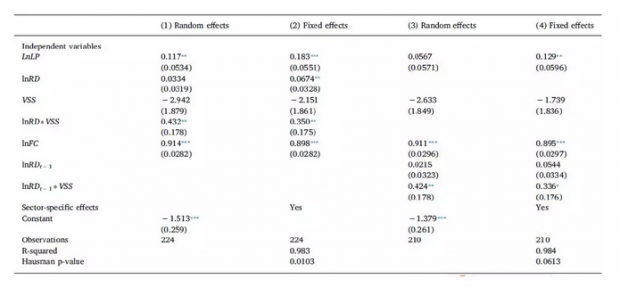阅读:0
听报道
推文人 | 徐莹莹
原文信息:ChunjiaoYu, Zhechong Luo.(2018). What are China's real gains within global value chains? Measuring domestic value added in China's exports of manufactures[J]. China Economic Review, 47, 263-273.
一、研究背景
在过去的20年中,中国越来越多地参与了GVC分工,并已成为一个重要的制造中心和出口平台。做为最大的出口国,“中国制造”的标签遍布全球市场。但是这也引发了一波又一波的“中国威胁论”。3月23日,特朗普签署备忘录,基于对华“301”报告,指令有关部门对从中国进口的约600亿美元商品大规模加征关税,并限制中国企业对美投资并购,对华实施贸易战。中美贸易失衡是贸易战的直接原因,但是“所见即为所得”吗?中国对美国的贸易顺差真有如此之巨吗?
在过去的几十年中,全球价值链分工(GVCs)不断深化,各国劳动分工已逐渐从产业间分工和产业内分工转向产业部门和“任务”部门。成品的国际贸易也逐步分散到“任务”贸易或网络贸易,使贸易驱动经济发展模式变得越来越复杂。相关国际经济学家已经达成共识,传统贸易统计数据不能准确地描述贸易模式的基本特征,也不能客观地衡量在全球价值链体系内不同国家真正的贸易绩效。在价值链体系下,传统贸易统计数据方法导致了重复计算和统计偏差,相反地,贸易增加值可以更好地衡量和反映全球贸易的新特点。那么,在GVC分工中中国实际收益到底是多少?中国国内出口附加值是由什么决定的?这正是本文试图回答的问题。
二、研究内容
作者首先对有关增加值贸易统计,贸易增加值的分解或测量及相关影响因素的研究进行了综述,并总结了现有研究的不足。区别于以往公司层面附加值测算方法,本文利用WIOD数据,借鉴Koopman等(2014)的方法从宏观层面测算中国的贸易增加值,并报告了测量结果。进一步地,作者根据Costinot等(2013)的研究,考察了劳动生产率、R&D投入、资本积累、垂直专业化程度等对增加值贸易的影响。
三、指标测度和统计说明
为了测量中国出口国内增加值(DVA),文章首先使用Koopman等(2014)的分析框架,分解一个特定国家的出口总值,以得到构成DVA的组件。文章中就测量方法进行了详细描述,DVA测量结果如下:

根据结果可知,总体上中国DVA总量呈上升趋势,但其数据远小于总的出口贸易量。而且通过比较与其他国家比较可以发现,中国DVA占出口的比例远低于发达国家,如美国、日本、加拿大和英国,制造业部分中国DVA的比例也低于美国和日本。
四、实证模型设定及结果分析
在计算DVA指标后,借鉴c等(2013)的研究成果,提出本文研究假设,实证检验影响DVA的因素,具体模型设定如下:

其中,lnDVAit表示i部门在t时刻出口国内增价值,lnLPit表示i部门在t时刻的劳动神产率,lnRDit表示i部门在t时刻的研发投入,lnVSit表示i部门在t时刻的垂直专业化程度, lnFCit表示i部门在t时刻的的资本积累量。
下表为回归结果,表明劳动生产率、研发投入、资本积累量和DVA呈正相关,虽然垂直专业化本身不会影响DVA,但是研发投入和垂直专业化的的协同效应会显著提升DVA。

五、结论
文章首先测度了中国出口的国内附加值(DVA),发现其数量与出口贸易量之间存在明显差距,且DVA占出口贸易的比例远小于发达国家。其次文章检验了劳动生产率、研发投入、资本积累以及研发投入和垂直专业化之间的协同效应对DVA的促进作用。
文章的研究结论表明,在GVC分工体系下,中国DVA比例小于发达国家,说明中国提供高质量产品的能力还远远落后于发达国家。贸易战也警示我们,出口应“重质大于重量”,在以后的出口中注重提升贸易附加值,具体地,应大力提倡技术发展,努力提升劳动生产率,鼓励研发,促进资本积累,并鼓励专业化生产。
Abstract
This paper aims to investigate China's gains of participating in global value chains (GVCs) in terms of GDP in exports (DVA - domestic value added) and the factors affecting China's gains. The paper decomposes the gross exports of China so as to get the components that make up total GDP in the exports of the country, namely the value-added exports and DVA that are returned from abroad. Then the two components are measured to obtain the scale of GDP in China's exports both on country and sector level. The results show that, firstly, both value-added exports and the GDP in China's exports are less than the traditional gross trade statistics, indicating that there is a gap of real trade gains under GVCs. Secondly, comparing whether the proportion of DVA in total exports, the proportion of DVA in exports of manufactures or the proportion of RDV in total DVA,the gaps between China and the developed countries such as the United States, Germany and Japan do exist. Especially, considering the RDV of China, the proportion is significantly lower than that of major developed countries such as the United States and Germany, indicating that China lags far behind developed countries in the capabilities of supplying high value-added intermediate goods. Lastly, the empirical results suggest that DVA in China's exports has progressively increased in response to the productivity enhancement; research and development (R & D) inputs and capital formation, and the synergies between R & D and vertical specialization affect China's DVA growth in exports positively.

话题:
0
推荐
财新博客版权声明:财新博客所发布文章及图片之版权属博主本人及/或相关权利人所有,未经博主及/或相关权利人单独授权,任何网站、平面媒体不得予以转载。财新网对相关媒体的网站信息内容转载授权并不包括财新博客的文章及图片。博客文章均为作者个人观点,不代表财新网的立场和观点。



 京公网安备 11010502034662号
京公网安备 11010502034662号 